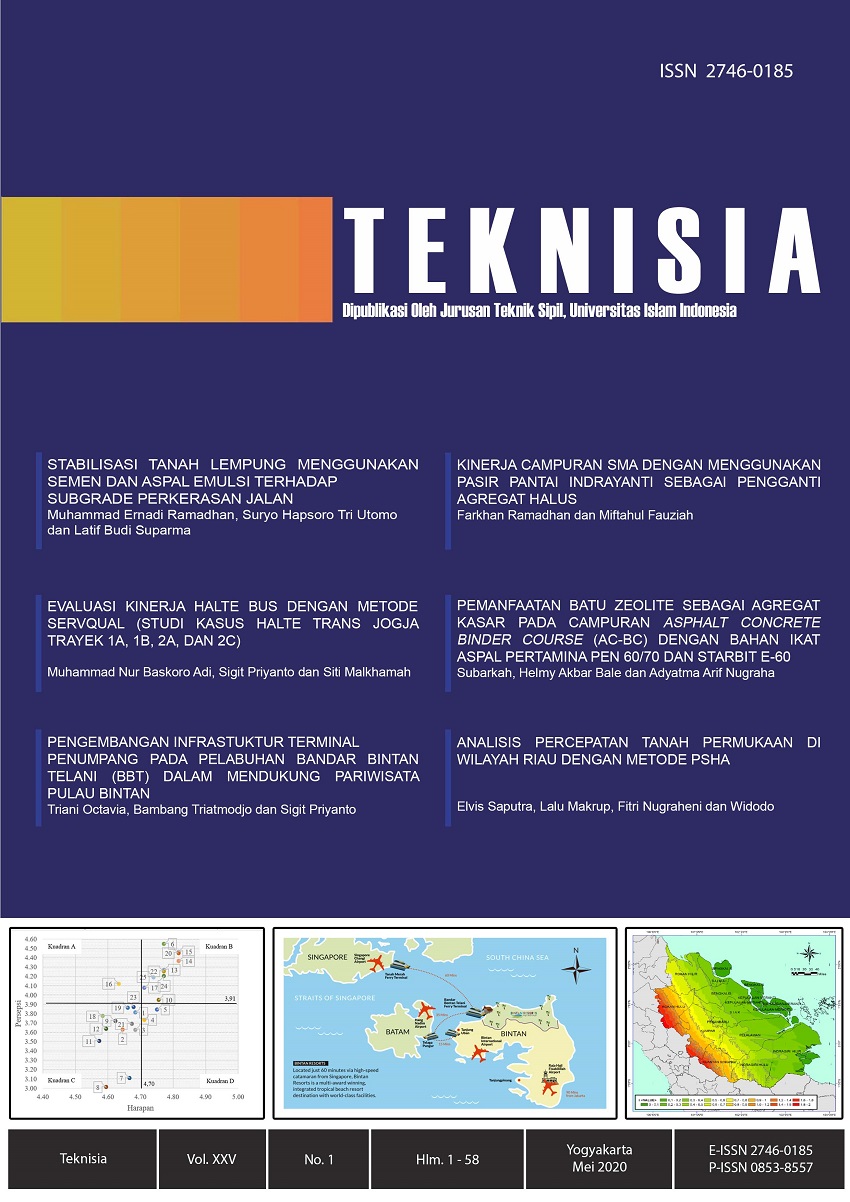Main Article Content
Abstract
Keywords
Article Details
Under the following term:
-
Attribution — You must give appropriate credit, provide a link to the license, and indicate if changes were made. You may do so in any reasonable manner, but not in any way that suggests the licensor endorses you or your use.
-
ShareAlike — If you remix, transform, or build upon the material, you must distribute your contributions under the same license as the original.
- No additional restrictions — You may not apply legal terms or technological measures that legally restrict others from doing anything the license permits.
References
- ASTM D1883-99. (1999). ”Standard Test Method for CBR (California Bearing Ratio) of Laboratory-Compacted Soils”. ASTM International. West Conshohocken, PA.
- ASTM D 698-00a. (2000). ”Standard Test Method for Laboratory - Compaction Charasteristics of Soils Using Standard Effort”. ASTM International. West Conshohocken, PA.
- Baghini, M. S., Ismail, A., dan Kheradmand, B. (2013). “The Potentials of Portland Cement and Bitumen Emulsion Mixture on Soil Stabilization in Road Base Construction”. Jurnal Teknologi (Sciences & Engineering) .Vol. 65.No.2, pp 67-72.
- Baghini, M.S., Ismail, A., dan Karim, M.R.B., (2015). “Evaluation of Cemet-Treated Mixtures with Slow Setting Bitumen Emulsion as Base Course Material for Road Pavement”. Journal of Construction and Building Materials.Volume 94, pp 323-336.
- Ingles, O.G., and Metcalf, J.B. (1972). “Soil Stabilization-Principles and Practice”. Sydney, Melbourne, Brisbane: Butterworths.
- Nugroho, U. (2003). “Pengaruh Penambahan Kapur dan Aspal Emulsi Terhadap Kembang Susut dan Daya Dukung Tanah Ekspansif Sebagai Subgrade Jalan”. Tesis. Program Pascasarjana Universitas Diponegoro. Semarang Tidak dipublikasikan.
- Pratama, F. (2018). “Stabilisasi Tanah Lempung Ekspansif Dengan Menggunakan Kapur dan Portland Composite Cement Pada Tanah Dasar Konstruksi Jalan”. Tesis. Teknik Sipil. Universitas Gadjah Mada: Tidak dipublikasikan.
- Road Research Laboratory. (1968). “Soil Mechanics for Road Engineer”. London: H.M. Stasionery Office.
- Yoder E.J dan Witczak M.W. (1975). “Principles of Pavement Design” Second Edition. New York: John Wiley & Son Inc.
- Zumrawi, M., (2015). “Stabilization of Pavement Subgrade by Using Fly Ash Activated by Cement”. American Journal of Civil Engineering and Architecture, Vol. 3, No 6, pp 218-22.
References
ASTM D1883-99. (1999). ”Standard Test Method for CBR (California Bearing Ratio) of Laboratory-Compacted Soils”. ASTM International. West Conshohocken, PA.
ASTM D 698-00a. (2000). ”Standard Test Method for Laboratory - Compaction Charasteristics of Soils Using Standard Effort”. ASTM International. West Conshohocken, PA.
Baghini, M. S., Ismail, A., dan Kheradmand, B. (2013). “The Potentials of Portland Cement and Bitumen Emulsion Mixture on Soil Stabilization in Road Base Construction”. Jurnal Teknologi (Sciences & Engineering) .Vol. 65.No.2, pp 67-72.
Baghini, M.S., Ismail, A., dan Karim, M.R.B., (2015). “Evaluation of Cemet-Treated Mixtures with Slow Setting Bitumen Emulsion as Base Course Material for Road Pavement”. Journal of Construction and Building Materials.Volume 94, pp 323-336.
Ingles, O.G., and Metcalf, J.B. (1972). “Soil Stabilization-Principles and Practice”. Sydney, Melbourne, Brisbane: Butterworths.
Nugroho, U. (2003). “Pengaruh Penambahan Kapur dan Aspal Emulsi Terhadap Kembang Susut dan Daya Dukung Tanah Ekspansif Sebagai Subgrade Jalan”. Tesis. Program Pascasarjana Universitas Diponegoro. Semarang Tidak dipublikasikan.
Pratama, F. (2018). “Stabilisasi Tanah Lempung Ekspansif Dengan Menggunakan Kapur dan Portland Composite Cement Pada Tanah Dasar Konstruksi Jalan”. Tesis. Teknik Sipil. Universitas Gadjah Mada: Tidak dipublikasikan.
Road Research Laboratory. (1968). “Soil Mechanics for Road Engineer”. London: H.M. Stasionery Office.
Yoder E.J dan Witczak M.W. (1975). “Principles of Pavement Design” Second Edition. New York: John Wiley & Son Inc.
Zumrawi, M., (2015). “Stabilization of Pavement Subgrade by Using Fly Ash Activated by Cement”. American Journal of Civil Engineering and Architecture, Vol. 3, No 6, pp 218-22.
